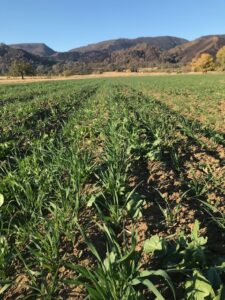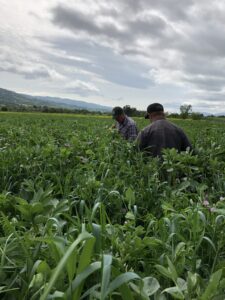
As you’ve hopefully heard, we’re fast approaching our annual winter break. We’ll be closed from December 13 through January 10 with just a skeleton crew making sure the plants and animals have what they need. During the break, we’ll be catching up on some much needed rest and we won’t be packing and delivering CSAs, making deliveries to stores and restaurants, or going to the farmers markets.
Until then we’ve got produce to harvest, transplants to get in the ground, and soil to prep. Some places on the farm have already started their break – our fields. After a summer being the home for tomatoes, melons, winter squash, eggplant, peppers, flowers, and more, they’ve earned their rest too. Some fields will be turned over to a winter crop right away but for those that we can rest, what’re our options?
Driving around Yolo County right now you see a lot of fields that recently had a crop and have been plowed, the rows have been shaped for next spring’s plantings, and they’ll be left as is until then. During the winter a few weeds will sprout, but they’ll largely stay as they look now, just exposed soil.
Fallowing is one option but it comes with significant risks and downsides and isn’t what we do. Instead we plant cover crops. They’re a key tool in the organic farmer toolbox and in many ways they’re one of our more important crops – so let’s explore what they are and why we plant them.
A cover crop is identified by its purpose not the plant type. A cover crop might be something that can be eaten but it’s grown to benefit the soil, not to yield a crop that will be harvested and sold.
If we don’t get paid for growing them, why do it? Cover crops can (1) slow or prevent soil erosion, (2) enhance water infiltration and water availability, (3) control weeds, pests, and diseases, (4) increase crop yields, (5) add nitrogen and other essential plant nutrients to the soil, (6) sequester carbon, (7) improve soil tilth and reduce compaction, and (8) create an ecosystem for beneficial insects and pollinators, and more. Over time, cover crops can increase crop yields and create better soil health. Soil is teaming with life that needs care and nourishment just like the plants do. While these crops don’t feed us, they do feed soil microbes and increase soil fertility. Cover crops are a long-term investment in health of the farm; often these benefits take a few years to reveal themselves. There’s a lot we do know about soil and the soil microbiome and the benefits of cover crops, but scientists are still uncovering more every year and the positive results have led the state of California to develop the Health Soils Program, which provides financial incentives to California growers and ranchers to implement conservation management practices, including cover cropping, that sequester carbon, reduce atmospheric greenhouse gases, and improve soil health.
If these benefits are so well known, then why don’t all farmers use them? A few key factors stand out. First, the cost – from the seed, potential irrigation, and the time and fuel used to plant and then eventually cut down and mow these crops. Then, the nutrients will not be immediately available to the plants, unlike synthetic fertilizers. Additionally, some plant species can act as a host for plant diseases and pests. And having to process the biomass from the cover crops can create scheduling and equipment challenges, especially in a wet year when the water-retaining skills of a cover crop can make a field too wet to work.
After weighing the tradeoffs, we think it’s worth it, as do many organic farmers, so we’ve got a decent chunk of our land planted in cover crops right now. What do we plant? We plant a cover crop mix, not just one plant. We use a mix of legumes (peas, vetch, fava beans, clovers), grasses or grains, and other plants like radish for the mix of benefits that they provide. Legumes will fix nitrogen, grasses add carbon, and large-rooted plants like radish break up the soil. We have cover crops going all seasons of the year, but we tend to do most in the winter since (in theory) rain will provide most of the irrigation.
So we’ve got a lot of fields that look like the picture on the left. By next spring, we hope it’s a tall, healthy cover crop (like the photo on the right). You’ll never see the cover crops in your box, but every bite of produce that you do enjoy is due in part to the cover crop that preceded it in the field.




